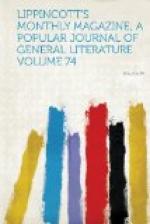Orange and almond trees, with other tropical plants, loaded with blossoms and fruit, beautify the lowlands, while in more elevated localities are found the fruits and foliage of the temperate zone, very many of them exotics brought by the settlers from their English homes. Down to the very water’s edge extends the verdure of tree and shrub, overshadowing to the right Fort Jackson, and to the left Middle Harbor. The Government House commands the bay with the imposing mien of a fortress, and the magnificent reception-rooms are worthy of a sovereign’s court. The garden surrounding it occupies a beautiful promontory, its borders washed by the sea, the walks shaded by trees imported from Europe, and the whole parterre redolent with tropical beauty and fragrance. On the promenades are frequently assembled at evening two or three hundred ladies and gentlemen in full dress, while military bands discourse sweet music for the entertainment of the brilliant throng.
Ballarat may be called the city of gold; Melbourne, of clubs, democracy and thriving commerce; Hobart Town takes the premium for hospitality and picturesque beauty; but Sydney bears the impress of genuine English aristocracy, in combination with a sort of Creole piquancy singularly in contrast with English exclusiveness, yet giving a wonderful charm to the society of this city of high life, so full of gayety, brilliancy and luxury. Who would recognize in the Sydney of to-day, with its four hundred thousand inhabitants, its churches, theatres and libraries, the outgrowth of the penal colony of Botany Bay, planted only eighty-seven years ago on savage shores? It was in May, 1787, that the first colony left England for Botany Bay, a squadron of eleven vessels, carrying eleven hundred and eighteen colonists to make a lodgment on an unknown shore inhabited by savages. Of these eleven hundred and eighteen, there were six hundred male and two hundred and fifty female convicts, the remaining portion being composed of officers and soldiers to take charge of the new penal settlement, under the command of Governor Phillip. From so unpromising a beginning has grown the present rich and flourishing settlement, and in lieu of the few temporary shanties erected by the first colonists there stands a magnificent city of more than ordinarily fine architecture, with banks and hospitals, schools and churches—among the latter a superb cathedral—all displaying the proverbial prodigality of labor and expense for which the English are noted in the erection and adornment of their public edifices. Among the educational establishments are the English University, with a public hall like that of Westminster; St. John’s College (Catholic); and national primary and high schools, where are educated about thirty-four thousand pupils at an annual expense to the government of more than three hundred thousand dollars. From the parent colony have sprung others, while the poverty and corruption that were the distinguishing features of the original element have been gradually lost in the more recent importations of honest and respectable citizens.




